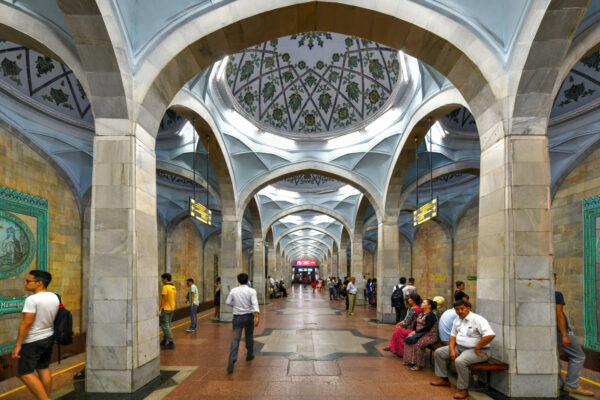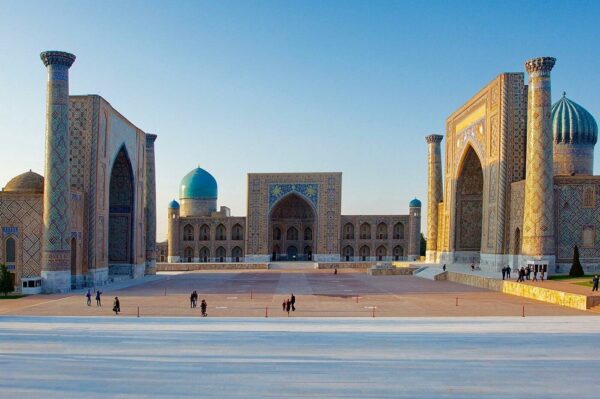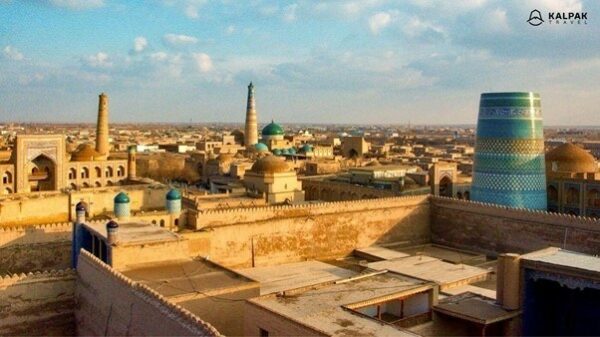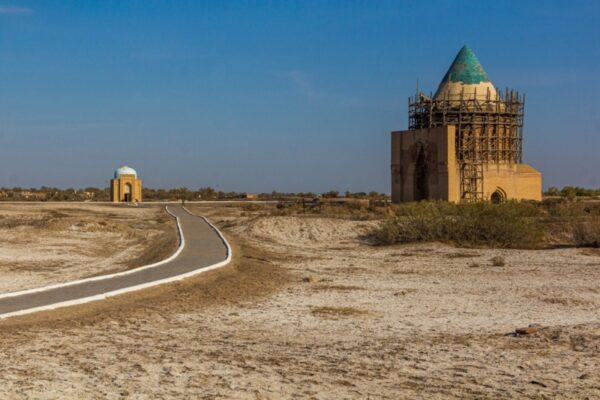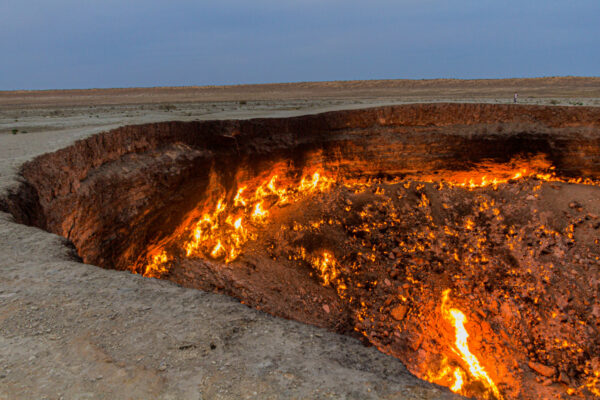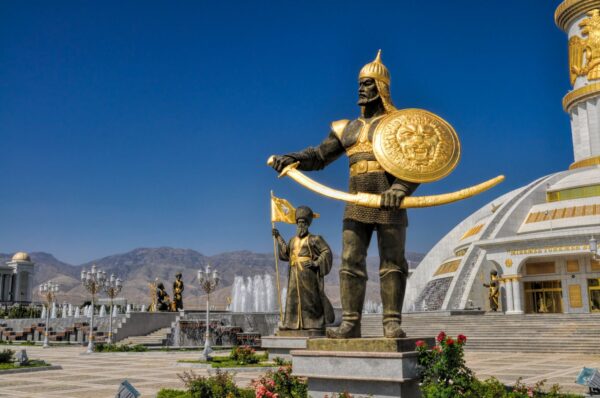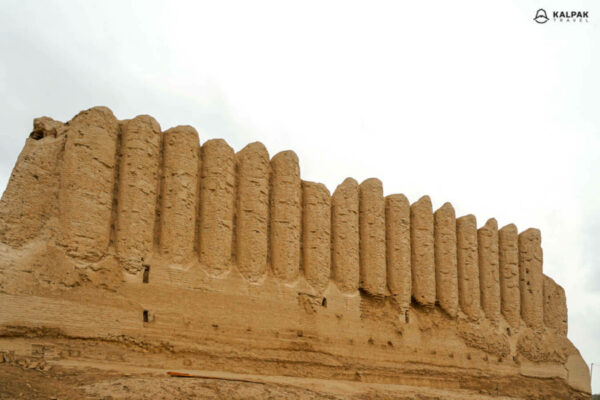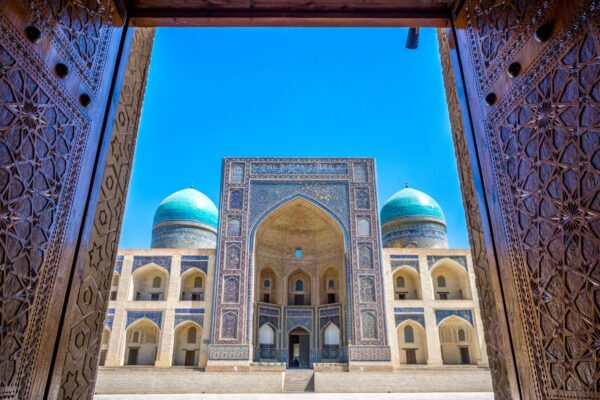Essential Uzbekistan & Turkmenistan
Explore the historical heritage of Persian Central Asia
While Uzbekistan is well-known for its history, few people realise current-day Turkmenistan also played an important role in the history of the Persian empires that ruled Central Asia for three millennia. This trip explores that history, visiting ruins across The Karakum Desert.
Less visited than Antarctica, you can be certain of a warm welcome from the Turkmen people. Key sights include the Darwaza gas crater and the marble extravaganza of Ashgabat making this an exciting once-in-a-lifetime trip.
This is a circular route, starting and ending in Tashkent. First, head to Samarkand to visit monuments like the Registan and Shah-i-Zinda.
Take the overnight train to Urgench from which it is a short drive to Khiva where you can take in the desert fortresses of Khwarezm.
Konye-Urgench is just across the border from Khiva, an ancient town full of ruins to explore. After spending the night at Dashoguz, the next day, camp out in the desert for Turkmenistan’s most famous sight, the Darwaza gas crater, also known as 'the Door to Hell'.
After a four hour drive across the desert, reach Ashgabat, one of the most relaxed areas to visit, budget an extra day here to wander unaccompanied and do some souvenir shopping.
Fly on to Merv and experience the fantastic echo in the lonely mausoleum of Sultan Sanjar and take a 4WD to visit the surrounding sights.
After crossing the desert one last time, you say farewell to Turkmenistan and arrive once more in the hustle and bustle of Uzbekistan. Bukhara possesses the nation’s most atmospheric hammam.
To return home, you can take the new fast train to Tashkent or opt to take the slow overnight train.
Key information
| Destinations | Turkmenistan, Uzbekistan |
|---|---|
| Activity | Active, Camping, Camel Trekking, Nature & Wildlife, National Parks, Culture, Cities, Museums & Galleries, History |
| Physical Level | Mild |
Suggested itinerary

Start in Tashkent
Day 1 in Tashkent
Tashkent is the start and finish of this route. The Tashkent metro has Central Asia’s most extensive network. You should not miss this underground experience: each metro station has its own theme, and some stations are as elaborate as those of the famous Moscow metro.

Explore Samarkand
Day 2–3 in Samarkand
A rebuilt 14th-century city, Samarkand in Uzbekistan is a striking place to visit with mosques covered in ceramic tiles and sand coloured buildings.
One of the major stops along the Silk Road, Samarkand is divided into the old city and the new city with the majority of historical monuments located in the old city.
The Registan is just one of the highlights, a large, open square (the name means “sandy place”) where people gathered, heard royal proclamations and watched executions. The buildings are covered in ceramic tiles and date back to the 15th century, restored in the 20th, they are among the finest examples of Islamic architecture anywhere.
Other sights include the Bibi Khanum Mausoleum, Ulughbek Observatory and a number of mosques and madrasas including the Ulughbek and the Shirdar Madrasas. The Shah-i Zinde is one of the key sights in Samarkand, which is a complex made up of mausoleums and mosques that houses the most important Muslim shrines that gives the complex its name, ‘the tomb of the living king’ - thought to be the grave of Qusam ibn-Abbas.
Paper-making is a craft that gets little attention among the splendour of Uzbekistan’s other artistic endeavors, but Samarkand’s paper museum is trying to change that. The museum traces down the history of paper from China to the Middle East and Europe, and shows the process as it is still being used today.
Drinkers, on the other hand, will enjoy a visit to the Hovrenko wine factory to hear the story of viticulture in a Muslim country.

Overnight train to Khiva
Day 4–5 in Khiva
The walled city of Khiva is made up of mud-brick buildings and has over 50 historic monuments meaning you will need a few days to explore the city. Its remoteness makes this desert khanate little-visited by the majority of tourists. Khiva is a picture postcard place, unique in the Islamic world for its intact historic center.
The unfinished Kalta Minor Minaret is a squat blue tower in the centre of the town, decorated with blue ceramic tiles, a staple of the city, and connected to the Mohammed Amin Khan Madrasa. Other sites include the Juma Mosque featuring ornately carved wooden pillars, the Pakhlavan Makhmud Mausoleum with its tiled dome and the Islam Khodja Complex.
Those with more appetite for the unusual can take a side trip to the remains of the Aral Sea. Rusty boats lie stranded in the desert with no shore in sight. The man-made catastrophe of the vanished Aral Sea is a reminder of the ongoing destruction of human habitat for economic gain.

Visit Konye-Urgench
Day 6–7 in Konye-Urgench
Konye-Urgench is just across the border from Khiva in Turkmenistan.
What dazzles most about the site at Konye-Urgench is not the giant minaret left standing or the showpiece mausoleums, but rather, what is not there. The empty spaces in between the glorious monuments speak not of a town, not of a city, but of a medieval metropolis worthy of the name “Heart of Islam”.
The Old Urgench ruins are a UNESCO World Heritage Site and there are a number of other archaeological sites including the Turabek-Khanum Mausoleum, Kutlug-Timur Minaret and the Tekesh Mausoleum.

Desert camping and the Darwaza gas crater
Day 8 in The Karakum Desert
The Karakum Desert covers a huge portion of Turkmenistan, bar the lizards, camels and other hardy wildlife, it is sparsely populated, with little rain falling across the area.
Few visitors travel into the country, which makes exploring the ruins an extraordinary experience. Although the destruction of cities such as Konye-Urgench and Merv, two of the largest and most influential, was thorough, you can visit the monuments which were either too beautiful or too strong for the Mongols to destroy and are now a UNESCO World Heritage Site.
You can also visit the Yangikala Canyon, a layered rock formations in various shades of oranges and reds.
An incredible spectacle, at the heart of the desert lies the Darwaza crater, also known as the Door to Hell, which is a large gas crater intentionally set on fire in the 70s to prevent methane escaping and it has continued to burn ever since.

Shopping in Ashgabat
Day 9–10 in Ashgabat
Ashgabat is a wonder, in that it is a huge, richly decorated, marble clad capital city that’s streets are largely empty of people.
Extravagant monuments and the golden statues of Turkmenbashi are key highlights of the city which holds the world record for the largest architectural star, among many other records including the world’s highest concentration of white marble buildings.
There are a number of museums, although entry prices can be high, such as the The Turkmen Carpet Museum, Fine Arts and the National Museum of History. There are also mosques and churches across the city with highlights being Turkmenbashy Ruhy Mosque and Ertugrul Gazi Mosque.
Any visit to Turkmenistan is necessarily guided, but Ashgabat is a place where rules are more relaxed. Budget an extra day here to wander unaccompanied and do some souvenir shopping. Besides sheepskin hats and intricate carpets, Turkmens are also famous for their ornate jewellery and their cognac.

Fly to Merv
Day 11–12 in Merv
If Konye-Urgench is impressive, Merv bowls you over. The scale is immense, and the fantastic echo in the lonely mausoleum of Sultan Sanjar makes it clear: this was an advanced civilization, now buried in the dust. A fortress built for the ages, now inhabited by camels. Here, too, find Turkmenistan’s Sufi heritage seeping through the cracks. Pilgrims circle graves, three times, anti-clockwise. Mutter prayers, tie ribbons. Then invite you over to join in a massive feast.

Stop at Bukhara
Day 13 in Bukhara
Bukhara is over 2,000 years old, built on the site of a former Buddhist monastery, it has hundreds of minarets, mosques and madrassas with key sites being the Kalyan minaret, that's tower is a prominent landmark of the city, the Ismail Samani mausoleum and Bolo Haouz Mosque, one of many UNESCO World Heritage Sites in the city.
It is a great place to stock up on souvenirs, from hand-painted ceramics to silk scarfs for the relatives. But remember, Uzbeks are a trader nation: if you haven’t bargained, you have been fooled!
Bukhara has the best sleeping options in all of Central Asia: top-notch service combined with historic authenticity at boutique hotels like Komil or Amulet represent Uzbekistan at its finest. Al fresco dining under centuries-old plane trees in one of the restaurants surrounding the Lyabi Haus quarter is a must.
The city is connected to Samarkand and Tashkent by high-speed rail making it easy to reach for tourists.

Back to Tashkent
Day 14 in Tashkent
To return home, you can take the new fast (four hour) train to Tashkent. Alternatively, take the slow overnight train for a second time round, and let the kedang-edang of metal on metal guide your meditation while you reminisce on a trip to remember.
Other itineraries you might like

Tajikistan & Uzbekistan Adventure
The Pamir Highway and the Uzbekistan loop
Approx. 21 days

